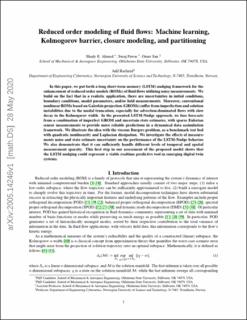Reduced order modeling of fluid flows: Machine learning, Kolmogorov barrier, closure modeling, and partitioning
Peer reviewed, Journal article
Accepted version

Åpne
Permanent lenke
https://hdl.handle.net/11250/2773869Utgivelsesdato
2020Metadata
Vis full innførselSamlinger
Originalversjon
10.2514/6.2020-2946Sammendrag
In this paper, we put forth a long short-term memory (LSTM) nudging framework for the enhancement of reduced order models (ROMs) of fluid flows utilizing noisy measurements. We build on the fact that in a realistic application, there are uncertainties in initial conditions, boundary conditions, model parameters, and/or field measurements. Moreover, conventional nonlinear ROMs based on Galerkin projection (GROMs) suffer from imperfection and solution instabilities due to the modal truncation, especially for advection-dominated flows with slow decay in the Kolmogorov width. In the presented LSTM-Nudge approach, we fuse forecasts from a combination of imperfect GROM and uncertain state estimates, with sparse Eulerian sensor measurements to provide more reliable predictions in a dynamical data assimilation framework. We illustrate the idea with the viscous Burgers problem, as a benchmark test bed with quadratic nonlinearity and Laplacian dissipation. We investigate the effects of measurements noise and state estimate uncertainty on the performance of the LSTM-Nudge behavior. We also demonstrate that it can sufficiently handle different levels of temporal and spatial measurement sparsity. This first step in our assessment of the proposed model shows that the LSTM nudging could represent a viable realtime predictive tool in emerging digital twin systems.